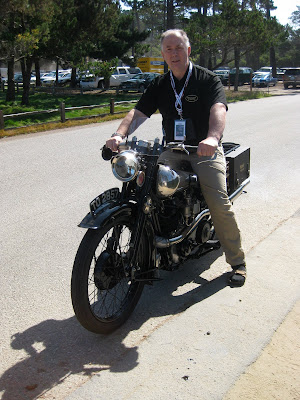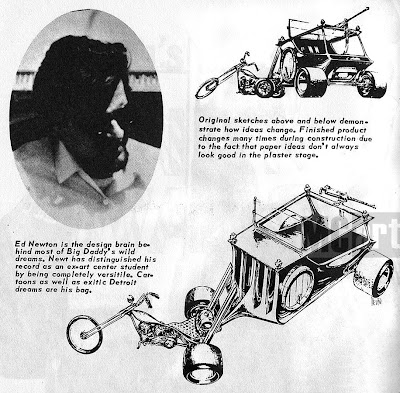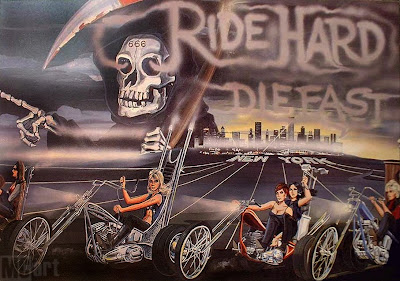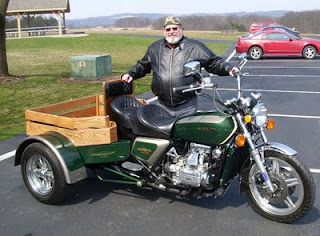By Simon de Burton
From
the Financial Times:
"As motorcycle launches go, this one was far from ordinary: the champagne was pink, the canapés were exquisite, the host wore black tie and the location could certainly be described as enlightening (an antique chandelier shop in
Chelsea's King's Road). I'd like to say it was all somewhat superior, but it was actually more than that - it was all rather Brough Superior.
The point of the soirée, you see, was to celebrate the fact than an Englishman called Mark Upham has delighted enthusiasts by returning Brough Superior to the road following its cessation of motorcycle production in 1940, having made little more than 3,000 machines in a a 20-year period. But what machines they were. "As fast and reliable as express trains and the greatest fun in the world to drive," is how Lawrence of Arabia described them, while the former editor of
The Motorcycle, H.D. Teague, summed them up as being quite simply "the Roll-Royce of motorcycles". It shows there was something to be said for the pursuit of perfection.
During the early 1900s, George Brough started working in his father's car and motorcycle business, but found that Pater's standards just weren't hight enough. so he left to set up his own company, wheeling the first Brough Superior out of his Nottingham workshop in 1919.
Within three years he was building his tuned SS80 model (guaranteed good for 80mph) and took to the track at
Brooklands. His fellow competitors laughed at Brough's pit-lane pampering of the bike he named
'Spit and Polish' - until he won the expert's scratch race and set a new 100mph lap speed. He won 51 of his next 52 races, too, only being denied victory in the last after he fell off. The bike, of course, dutifully kept goin and crossed the finish line first.
By the time Brough had introduced his SS100 model in 1924 (each one tested by the proprietor at 100mph) and the Alpine Grand Sports for hard-riding tourists, the Brough Superior legend was established and had
Lawrence of Arabia as its most famous patron - he bought his first in 1922 and called it Boanerges, following with six others named George II, III, IV, V, VI, and VII. He died on the George VII in May 1935 while awaiting delivery of the eighth, after he swerved to avoid two boys on bicycles and then crashed.
Lawrence and writer
George Bernard Shaw were among several big names drawn to Broughs for their exceptional fit and finish, their relative exclusivity, and no doubt, their reassuring high price tags. Brough fans enjoy quoting the fact that, at around £150, an SS80 cost more than a small house in 1923.
Such attributes have made original models highly sought-after;
Bonhams sold two bikes in 2008 for £166,500 (a world record for a UK motorcycle) and £151,100 respectively - which is why Upham's decision to make and sell brand-new Brough Supriors that look exactly like those of old is attracting global interest.
He has read the market well. During the past five years he has sold 46 original examples from
BoA (British Only Austria), the thriving classic motorcycle business that he runs from a substantial farmhouse in the small
Austrian town of Pettenbach, supplying rare machines and parts to all corners of the globe.

However, Upham will only say that there are Brough Superior original on the market for between £250,000 to £1m. (Lawrence of Arabis's 'death bike', incidentally - which was privately owned and shown at London's Imperial War Museum in 2006 - could be worth up to £1m, although its owner turned down an offer of $2.5m in 1997).
Upham, 53, set up his first motorcycle shop in Somerset in 1977, having left his
Hampshire boarding school, Red Rice, to attend agricultural college where he spent most of his time 'learning to weld'. He had harboured a desire to reinstate Brough since buying his first example as a wreck, aged 19, but it was not until the trademark, name, and intellectual rights (for the UK, EU, and Japan) appeared in a Bonhams sale catalogue in 2007 that his dream became a possibility.
In the event, the lot was withdrawn, and Upham entered int negotiations to buy it privately. He finalised the deal in 2008 and spent the following year working on a trio of prototypes with the look, sound and performance of the original but built using 21st-century materials and engineering that would have been beyond the wildest dreams of the nit-picking George Brough.
The modern-day Brough contains few English-made components simply becuase Upham has some of the best engineering facilities in the world on his doorstep some casts will come from a workshop just an hour from home that produces parts for Lamborghini and Audi; engine crankcases will be made across the border in Germany; and the frames have been designed and stress-tested at
Austria's Leoben University to ensure thy are of a higher specification than the less-then-perfect originals.
Upham's project quickly came to the attention of an American road-building tycoon who offered to sponsor him to appear with two prototypes at
2009's Pebble Beach Concours d'Elegance, the presigious classic car show that is visited by some of the world's wealthiest petrolheads. Among those attneding was television host and motorcycle nut Jay Leno who said the new Broughs were 'the best thing he'd ever seen at the event'. The owner of six originals, Leno was at first convinced that the replicas were immaculately restored examples from the 1920s and had one of them removed from its stand so that he could be filmed riding it for his car-and-motorcycle themed website (
www.jaylenosgarage.com).

"To see a brand-new one [Brough Superior] was stunning", Leno said afterwards. "Everything was just as it would have been in 1925. To be able to thrash is as you would a new motorcycle back in the day was pretty amazing. It was a real thrill. During the war people put them away in their sheds an covered them with straw to save them from being taken for scrap for the war effort, because they were just so valuable."
Upham has so far completed new version of the Alpine Grand Sports tourer and the legendary Pendine racing model, so named after taking first and second place at the
1928 Pendine one-mile sprint race. Only one machine has been sold - to the supportive American highway builder whose private mechanic is currently engaged in long-term tests of the machine at
La Rochelle, France.
The order book is, however, now open for production to commence - but don't all rush at once becaues tehse machines are not going ot be cheap "I don't wish to say how much one will cost, but it will be a six-figure sum. It will be less than the price of a good, original example - but still as much as a small house in some places," says Upham, cryptically. "The website is currently attracting 1,000 hits a month, but one of the main aspects of the bike is that it will be mega-exclusive. I have had letters asking: 'How much is it?' but this misses the point. Not wishing to sound arrogant, but if you're concerned about how little you can buy it for, you're not the person for a Brough Superior. I'd rather sell five machines to people I like and who understand than 25 to people I don't like - those who write me a nice letter get a positive response", says Upham, who is happy to produce three to six bikes a year. "I'm fortunate in not needing to do anything fast", he adds.
It may sound like an eccentric way to do business, but Upham is not taking the potential of Brough Superior lightly. The motorcycles will remain core, but he has made sure that the name can be licensed for use on any number of products. "I would like Brough Superior to be a household name. I have registered it in Europe for everything from beers and wines to jewellery, jackets and shaving foam, and I'm looking for merchansdising partners. That way we can create our own capital to keep building motorcycles without borrowing money", says Upham.
Brough Superior champagne, anyone?"














.jpg)






















